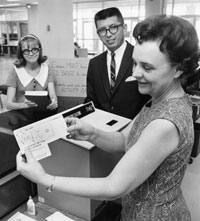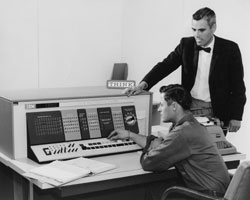YESTER
YEAR
Computer evolution
University’s early models contained no data storage devices
Three undergraduates tap the keyboards of their high-powered laptops in a Nedderman Hall corridor. Working on a class project, they're oblivious to seven glass cases within 20 feet that house some of the earliest personal computers: an Altair 8800b, an IBM PCjr, an Apple Lisa.
The electrical engineering students weren't even born when these rudimentary PCs hit the market in the 1970s and '80s. The bulky boxes are part of the Museum@CSE, a piecemeal collection of old technology stashed on the building's first and third floors.

Library assistant Norweita Graham displays a computer punch card used in the library's check-out system in 1969.
The first computers on campus predate these relics by nearly two decades. In 1961 the administration used an IBM 1401 for payroll and grade reports, while academic areas used an IBM 1620 Model I located in the Engineering Building (now Woolf Hall).
Tom Kennedy, a student at Arlington State College (now UT Arlington) in 1961 and later operations manager for Academic Computing Services, remembers that the first academic computer read punch cards and produced a paper printout.
"It was so loud, it sounded like a thrashing machine," he said.
That first model contained no data storage devices, but a 1620 Model II bought in 1963 had two disk drives for storage.
"These machines were 6 feet wide by about 6 feet high, yet they only contained 8K of storage space," recalled Kennedy, who retired in 2000. That's a fraction of what a 5¼-inch floppy disk holds, and those became obsolete in the 1980s.
Melvin Pierce came from General Dynamics to join the faculty in 1961 and taught the first course in Fortran programming.
ACS (now the Office of Information Technology) became a department in 1967 with Pierce the director. The University bought a Xerox Sigma 7 and housed it in the Engineering Building. Later, the IBM 1620s and the Xerox Sigma 7 were moved to Ransom Hall, where ACS programmer and operations departments were set up.
Engineering and ACS soon needed more space, so in 1970 all computer equipment and personnel moved to the basement of Davis Hall, which extends underneath Texas Hall.
"There was just dirt and piers beneath Texas Hall," explained Pierce, who retired in 1992. "So the dirt was excavated and the area designed to meet the needs of ACS."
Some believed the computers were placed underground for security concerns compounded by the Vietnam War. Others theorized it was to avoid interference when the computers were in use.
"I believe we were down there because there was space for us and because nobody else wanted to be down there," Pierce said with a laugh.

Melvin Pierce, right, works with a student on an IBM 1620 Model I in the early 1960s.
Broken pipes flooded the basement more than once.
"I purchased several pumps and hoses to bail out the water, hoping I'd never need to use them," Kennedy said. "Well, we definitely needed to."
The University of Texas Regional Computer Center, located at UT Southwestern Medical Center at Dallas, had the mainframe that controlled many UT System computer operations from 1973-77.
When UTRCC was closed and individual campuses again became responsible for their own computing needs, ACS expanded from just maintaining terminals connected to UTRCC to being responsible for generally all computing needs on campus, computer science and engineering Lecturer Tom Rethard said.
Today, UT Arlington's vast computing landscape includes a high-performance cluster that supports multimillion-dollar research projects and several other centralized resources that support academics. OIT manages 10 computer labs featuring more than 900 computers and provides a high-speed campuswide data network that was unfathomable in the early '60s.
In another 45 years, perhaps today's equipment will be part of a much larger museum dedicated to the history of technology. Gil Carrick, a former computer science and engineering lecturer who maintains the Museum@CSE, and others have created a nonprofit organization, the Arlington Museum of Information Technology, to manage the resources.
Harley Courtney, a retired accounting professor, and his son, Lee, who worked for ACS during the 1970s, have contributed extensively to the holdings. Items include punch cards, calculators, hardware, floppy disks, even a slide rule. And those clunky PCs.
Back in Nedderman Hall, what do the three electrical engineering students think of the early models? Says one:
"Dinosaurs."
— Jim Patterson
Other Stories
Former cadets Irish, Schneider join military hall
Mavericks Personified: The 440 Alliance
Innovative band of alumni disturbs the peace with 16 strings (and drums)
Cradle of ingenuity
Wireless sensors aim to prevent sudden infant death syndrome
Strokes of genius
Golf team earns first top-20 ranking after record-setting fall season
Computer evolution
University’s early models contained no data storage devices
Contact Us
Office of University Publications
502 S. Cooper St.279 Fine Arts Building
Box 19647
Arlington, TX 76019-0647
